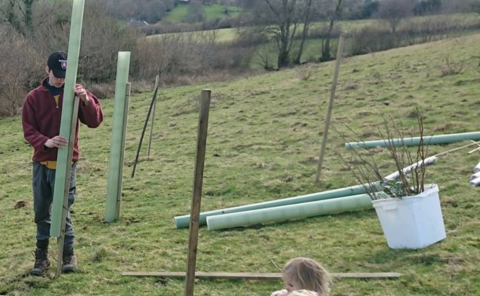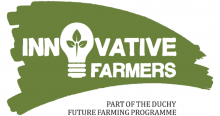Planting trees to suit grazing requirements
Each design has been chosen to suit the grazing requirements of the farmers as well as fitting into the natural environment surrounding the chosen fields. Seven farms across Devon are testing these designs as part of 12 years of farmer led research into agroforestry. The results aim to provide the first ever set of long term data which is practically grounded in the reality of commercial farms. This will give more farmers the confidence to plant trees into their grazing systems.
The designs have been chosen to suit a range of needs so if you are a livestock farmer there is a good chance the principles of one of these designs will suit your needs.
Design agroforestry for your farm
But what do the designs looks like? Why were they chosen? And what benefits are they hoped to bring? Three farmers below have volunteered to share the designs they worked on with the help of The Woodland Trust and FWAG Southwest.
This field lab is also partnered with Rothamsted Research and Organic Research Centre.
Henry Andrews is trialling regular spaced agroforestry strips on his farm.
Henry is part of a 12 year farmer-led research project into silvopasture. Click here to follow how it's progressing.
How regular spaced strips fits into the farm business
Henry is a conventional beef farmer located in north west Devon. The land he wanted to convert to silvopasture is exposed heavy land. The chosen field is a 4.5 ha field on the edge of a moor with high wind speeds often blowing from the west. The design is chosen to provide dappled shade and scattered shelter for the animals. Henry wanted to introduce trees in regular spaced strips onto the field without restricting access to machinery in case he needs access for cutting silage. The strips are fenced off so Henry can create a paddock system in the five years while the trees establish themselves meaning very little land is taken out of productive use in this time. After the trees are established the fences will be changed from north to south to east to west so the paddock system runs through the tree strips. This will allow the cattle to browse across the tree strips and have access to fodder and nutrition while maintaining the mob grazing system.
The silvopasture design for regular strips
Nine rows of trees were planted on the field, each 20 metres apart from the other. In the rows the trees are spaced 2.2m apart. The rows are planted with trees alternating with shrubs as seen in the diagram below. Three hawthorn shrubs are planted around each tree to ensure they are protected from rubbing when the cattle are let back in. Hawthorn is chosen as it is spikey but unlike blackthorn it doesn’t sucker into the field which would create unwanted spread into pasture. Trees will be protected with 1.8m guards and the shrubs are planted in spiral protectors at 0.75cm tall.
Why choose the regular strips agroforestry design?
- Planting in rows means that each row of trees can be protected with electric fencing. This allows grazing in the field while the trees get established and results in minimal land being taken out of production while they grow.
- The area between each strip of trees is roughly an acre to get an even paddock system across the field for the mob grazing. The plan is the livestock will rotate every day from each paddock to the next which will in turn increase the productivity of the sward.
- With 20m spacing between rows of trees, the parcel can be easily accessed by machinery, allowing it to continue being cut for silage through the establishment period and beyond.
- Height of spiral guards chosen to ensure that when deer inevitably graze the shrubs back it will encourage the plant to grow in a prostrate style meaning it stays low enough to provide long term access for forage.
The benefits of regular strips silvopasture design:
- The trees will grow tall and provide shade and shelter at regular intervals across the field. Research shows that when livestock have ample regular dappled shade with constant access to available forage, they can continue active grazing through the heat of summer days. Otherwise they often choose to rest in the section of the field that has the most shade, reducing forage intake and daily liveweight gain.
- The trees will bring up trace minerals from deep in the ground, providing nutrition for the livestock and access to the ability to self-medicate which can be beneficial for intestinal parasite control.
- Henry can still get machinery down the alley so can silage can still be cut meaning most of the field will continue to be managed as productive grassland throughout the year.
- Strips of trees provide in field habitats for wildlife.
- The design is compatible with continued BPS payments through the establishment period.
Drawbacks of regular strips silvopasture design:
- As grass productivity has been prioritised this design has the least biodiversity benefits of the three examples shared in this article.
- Significant amounts of electric fencing are needed to protect each row of tree.
How many trees and shrubs in regular strips silvopasture design
| Standard Trees (% total) | No. | Shrubs (% total) | No. |
| Downy birch (10%) | 86 | Elder (5%) | 43 |
| Field maple (5%) | 43 | Holly (5%) | 43 |
| Oak (20%) | 183 | Elm (10%) | 86 |
| Scots Pine (5%) | 43 | Spindle (5%) | 43 |
| Sycamore (5%) | 43 | Willow (15%) | 140 |
| Alder (5%) | 43 | Hazel (10%) | 86 |
| Hawthorn (separate) | 1355 |
How much does the regular strips silvopasture design cost?
| Item | Unit |
| Total area of field (ha.) | 4.51 |
| Length of strips | 2196m |
| Number of trees | 900 |
| Number of thorns | 1350 |
| Spacing between trees | 2.4m |
| Cost of trees | £1381.50 |
| Cost of thorns | £810 |
| Cost of fence | £5270 |
| Total | £7,731.90 |



